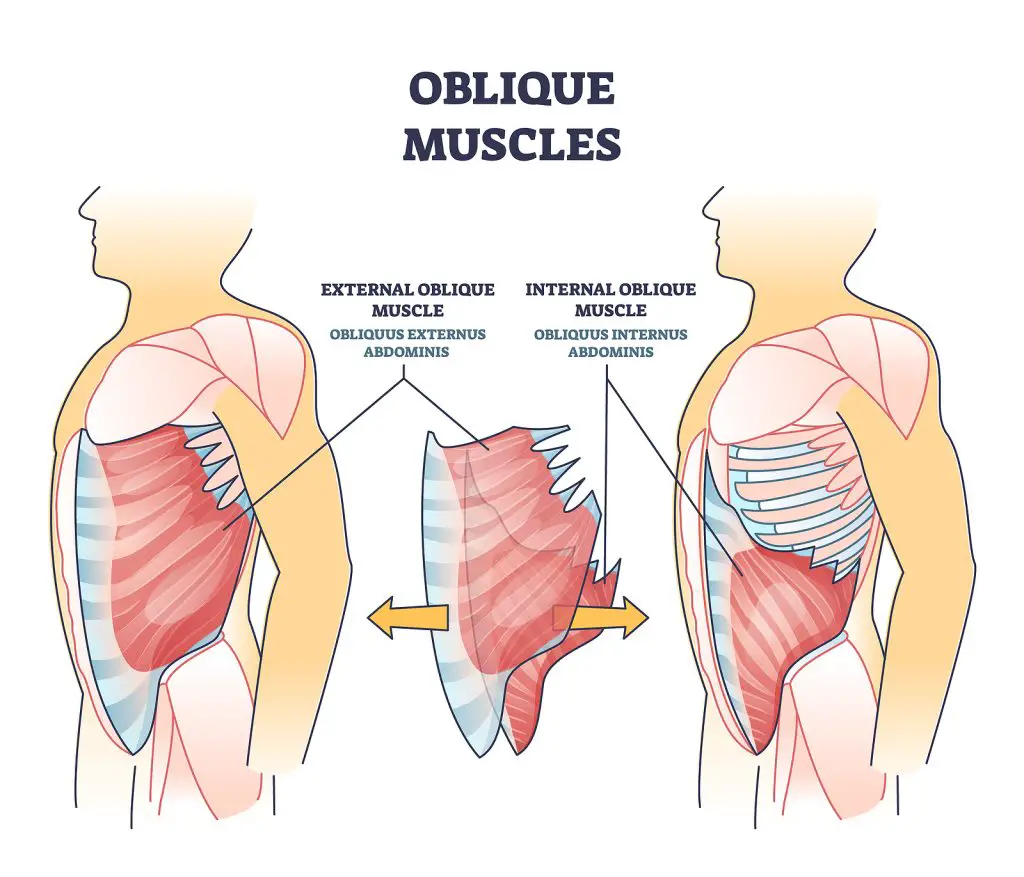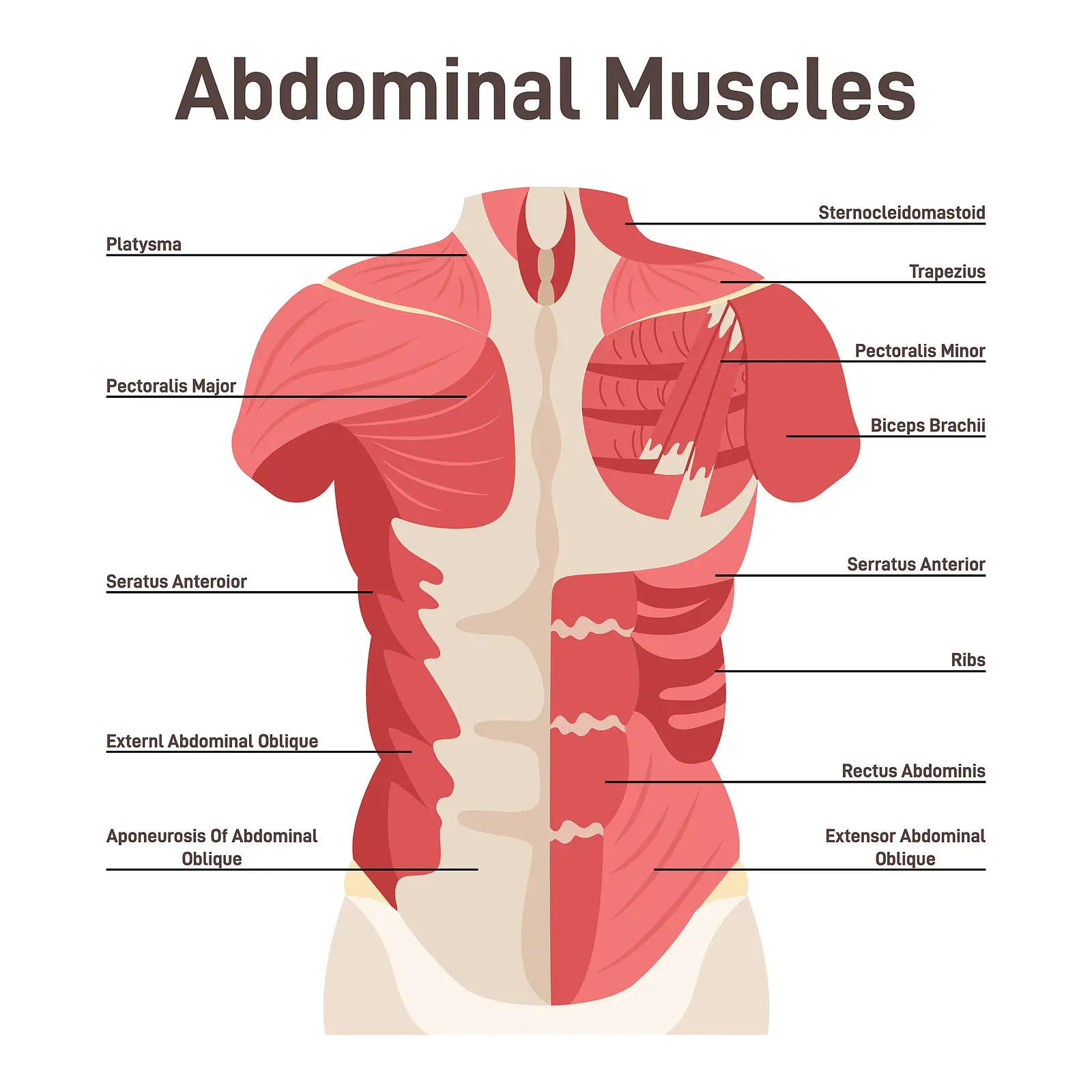The abdominal muscles are a group of muscles located in the abdomen, which is the area between the chest and the pelvis. These muscles play a crucial role in various bodily functions, such as maintaining posture, supporting the spine, and facilitating movement. They also contribute to core stability and protect the internal organs within the abdominal cavity. Understanding the anatomy of the abdominal muscles is essential for athletes, fitness enthusiasts, and healthcare professionals alike.
The abdominal muscles can be divided into several groups, including the rectus abdominis, external obliques, internal obliques, and transversus abdominis. The rectus abdominis is the most well-known abdominal muscle, commonly referred to as the “six-pack.” It is a long, paired muscle that runs vertically down the front of the abdomen and is responsible for flexing the spine and compressing the abdominal cavity.
The external and internal obliques are located on the sides of the abdomen and play a crucial role in trunk rotation and lateral flexion. The transversus abdominis is the deepest abdominal muscle and acts as a stabilizer for the spine and pelvis.
To visualize the abdominal muscles, imagine a corset wrapped around the abdomen. The rectus abdominis forms the front part of the corset, while the external and internal obliques wrap around the sides, and the transversus abdominis acts as the innermost layer.
These muscles work together to provide support and stability to the core, enabling various movements and protecting the organs within the abdominal cavity. By understanding the anatomy of the abdominal muscles, individuals can effectively target and train these muscles to improve core strength, posture, and overall fitness.
Anatomy of the Rectus Abdominis
The rectus abdominis, also known as the “six-pack” muscle, is a long, flat muscle that extends vertically along the front of the abdomen. It is one of the main muscles responsible for core stability and is located between the ribs and the pelvis. The rectus abdominis is divided into multiple segments by tendinous intersections, which give it the characteristic appearance of a “six-pack” in individuals with low body fat.
The rectus abdominis muscle originates from the pubic symphysis and inserts on the fifth, sixth, and seventh ribs. It is enclosed in a fibrous sheath called the rectus sheath, which is formed by the aponeuroses (flat, sheet-like tendons) of the external oblique, internal oblique, and transversus abdominis muscles. This sheath provides additional support and protection to the rectus abdominis muscle.
The main function of the rectus abdominis is to flex the trunk, bringing the ribcage closer to the pelvis. It also assists in stabilizing the pelvis during movements such as walking, running, and jumping.
Additionally, the rectus abdominis plays a role in respiration by assisting in forced exhalation. Overall, understanding the anatomy of the rectus abdominis is crucial for athletes, fitness enthusiasts, and healthcare professionals alike, as it helps in developing core strength, diagnosing abdominal injuries, and planning surgical procedures in the abdominal region.

Anatomy of the Obliques
The oblique muscles are a group of abdominal muscles that play a crucial role in core stability and movement. There are two sets of oblique muscles on each side of the abdomen: the external obliques and the internal obliques.
The external obliques are the largest and most superficial of the oblique muscles. They originate from the lower eight ribs and run diagonally downward toward the midline of the abdomen.
The internal obliques lie underneath the external obliques and run in the opposite direction, from the midline of the abdomen towards the lower ribs. Together, the oblique muscles form a strong, layered structure that provides support for the trunk and aids in various movements such as bending, twisting, and side bending.
The external obliques are primarily responsible for rotating and bending the trunk. When both sides of the external obliques contract simultaneously, they help to flex the spine forward, bringing the chest closer to the pelvis.
Additionally, when only one side contracts, it aids in lateral flexion and rotation of the trunk. The internal obliques have a similar function but with some variations. When both sides contract, they contribute to trunk flexion and rotation.
However, when only one side contracts, the internal oblique muscles act to tilt the pelvis and assist in lateral flexion of the trunk. Both sets of oblique muscles work in coordination to provide stability and control during movements and play an essential role in maintaining proper posture.
It is important to strengthen and stretch the oblique muscles to maintain a healthy and functional core. Exercises such as side planks, Russian twists, and bicycle crunches target the oblique muscles and help to increase their strength. Stretching exercises like standing side bends and seated twists can also help to maintain flexibility in the obliques.
Developing strong and flexible oblique muscles can improve overall core stability, enhance athletic performance, and reduce the risk of injuries during physical activities. Regular exercise and proper technique are key to effectively training and maintaining the health of the oblique muscles.
Anatomy of the Transverse Abdominis
The transverse abdominis is a crucial muscle that forms a deep layer of the abdominal muscles. It is located beneath the internal obliques and rectus abdominis muscles. The transverse abdominis is a broad and thin muscle that runs horizontally across the abdomen. It spans from the lower ribs to the pelvis and connects to the linea alba, a fibrous band that runs down the center of the abdomen.
The main function of the transverse abdominis is to stabilize the abdominal wall and provide support to the spine. It acts as a natural corset, compressing the abdominal contents and increasing intra-abdominal pressure. This contraction of the transverse abdominis helps protect the organs and maintain proper alignment of the spine, which is essential for maintaining good posture and preventing lower back pain.
Engaging and strengthening the transverse abdominis is important for overall core stability. It is often referred to as the “core muscle” because of its role in stabilizing the trunk. Exercises that target the transverse abdominis include planks, bird dogs, and vacuum exercises. These exercises involve contracting the transverse abdominis without engaging the other abdominal muscles, which helps to improve core strength and stability.
In conclusion, the transverse abdominis is a deep abdominal muscle that plays a vital role in stabilizing the abdominal wall and supporting the spine. Understanding its anatomy and function is crucial for maintaining good posture, preventing lower back pain, and improving core stability. By incorporating exercises that target the transverse abdominis into your fitness routine, you can strengthen this muscle and enhance your overall abdominal strength and stability.
Function and Importance of the Abdominal Muscles
The abdominal muscles are a group of muscles located in the front of the abdomen. They play a crucial role in providing stability and support to the trunk, as well as aiding in various movements of the body. The main function of the abdominal muscles is to flex and rotate the trunk, allowing for movements such as bending forward, twisting, and turning. These muscles also help maintain proper posture and protect the internal organs within the abdominal cavity.
The importance of the abdominal muscles cannot be overstated. Strong abdominal muscles are essential for maintaining overall core strength and stability. They provide a solid foundation for all movements of the body, whether it be lifting heavy objects, participating in sports, or simply performing daily activities.
Weak abdominal muscles can lead to poor posture, lower back pain, and an increased risk of injury during physical activities. Additionally, having well-developed abdominal muscles can contribute to a more toned and defined appearance, which many individuals strive for.
To strengthen the abdominal muscles, there are various exercises that can be incorporated into a fitness routine. Some popular exercises include crunches, planks, Russian twists, and leg raises. It is important to note that proper form and technique should always be maintained to prevent injury and maximize the effectiveness of the exercises.
Additionally, it is recommended to incorporate a variety of exercises that target different areas of the abdomen to ensure balanced muscle development. Consistency and gradual progression in intensity and difficulty of the exercises are key to achieving strong and functional abdominal muscles.






Leave a Reply